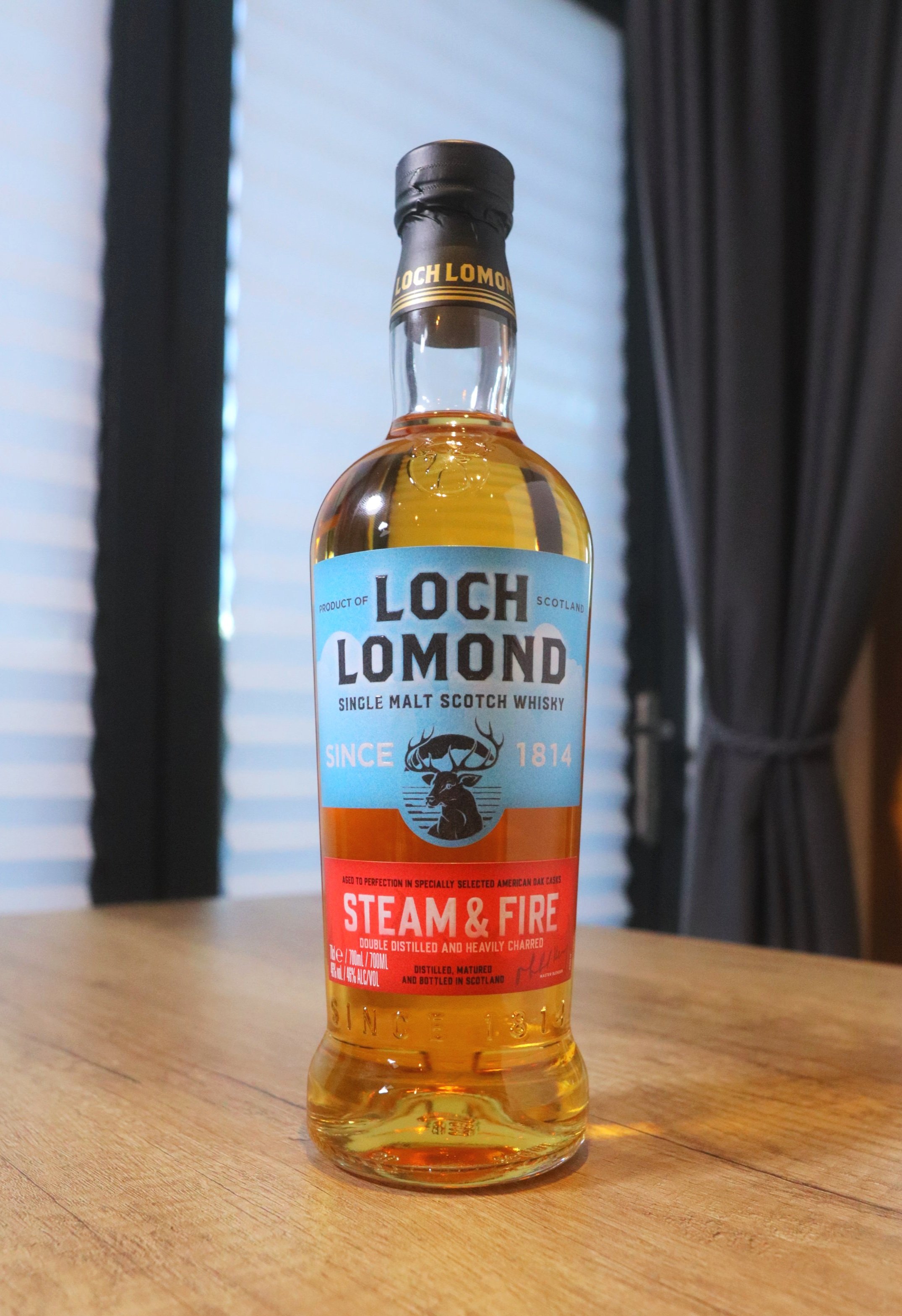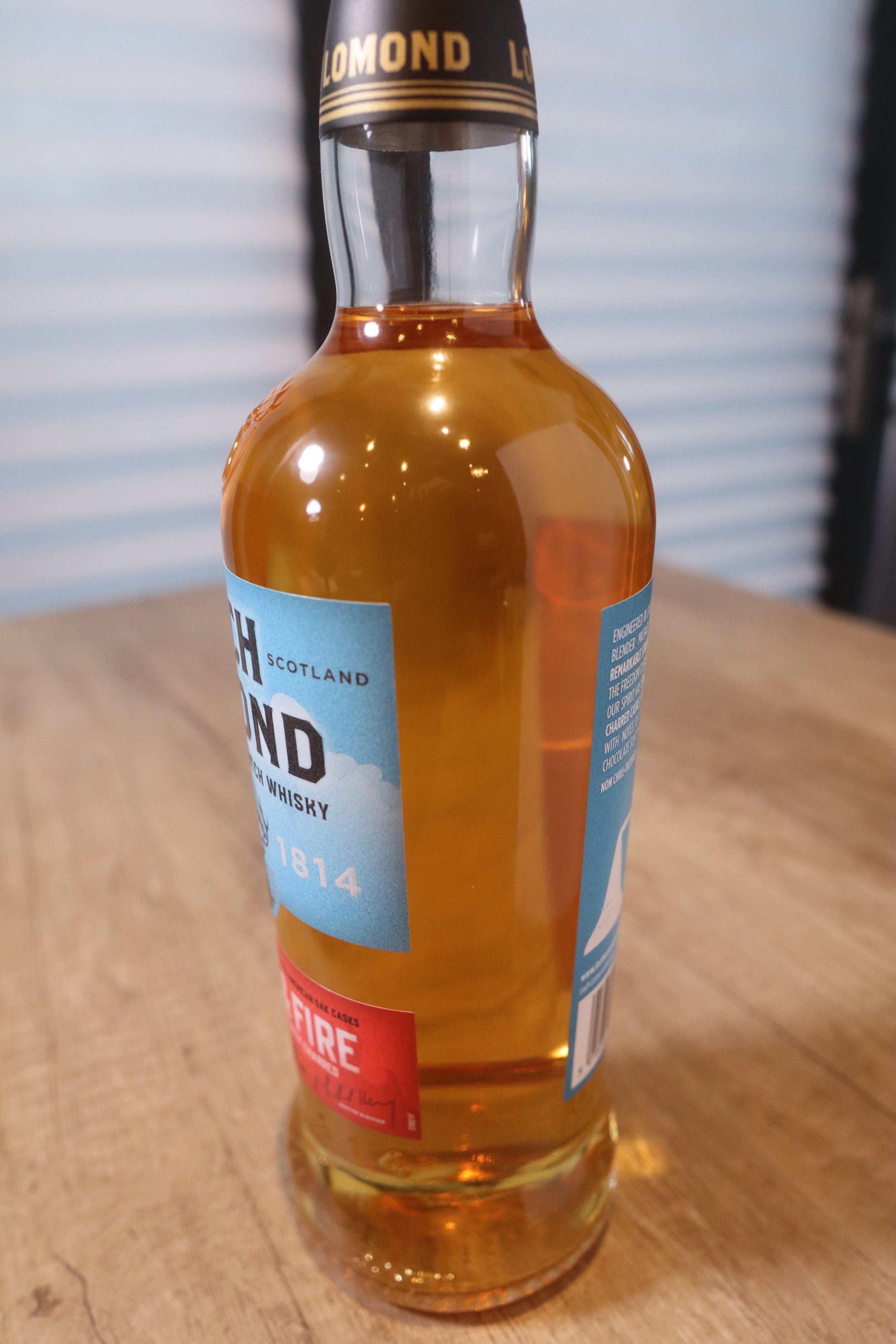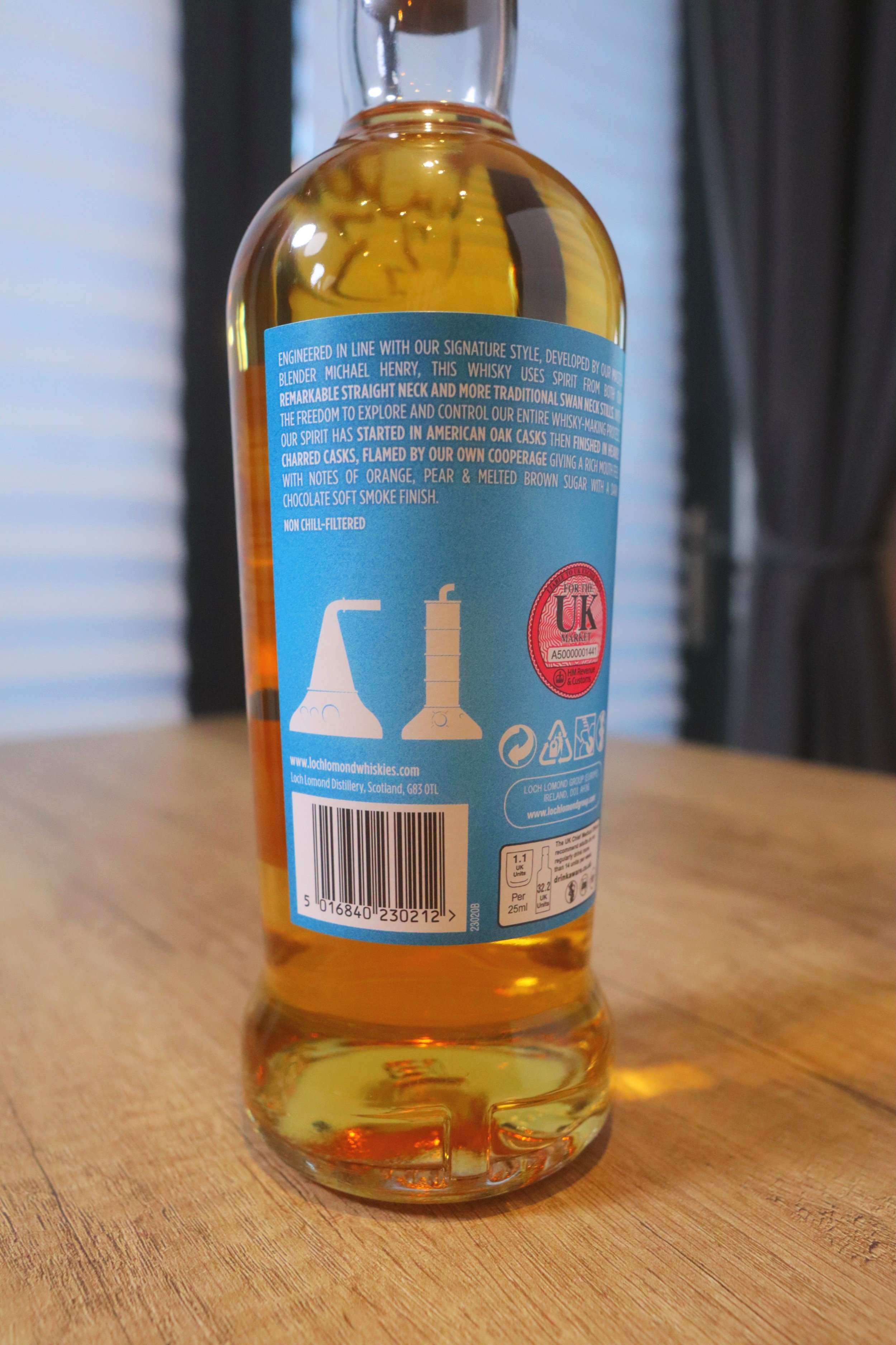Loch Lomond Steam & Fire
NAS Official Release | 46% ABV
Score: 7/10
Very Good Indeed.
TL;DR
Bright, fresh and beautifully honest
What’s the colour of whisky?
This was supposed to be a Glenglassaugh review, their shiny new 12 year old release has been around for a wee while now and I’ve been chewing on it. My nosing and tasting notes are down. I might have lost the memory card with the photos on it, but I’m sure it’ll turn up.
If not, I'm confident the pretty bottle will still photograph nicely when it’s almost empty, so I settled down to write about what should be an exciting renaissance release from the Eastern Highlander. But this bottle has been shouting its presence since it arrived and I decided to switch.
The Glenglassaugh is good, but where it has chosen to shun some opportunities, as mentioned by Earie in his review of an 8yo indie ‘glassaugh, this Loch Lomond is yet another harbinger of positive change. Tonight, I’d rather celebrate than whinge. So into the glass slushes my third pour as I set about why I’m happy this is here.
First up - and I think I won’t be alone in this - I’m not a fan of the aesthetic. They’ve followed the obvious on the Steam & Fire theme and gone with a watery blue and tonally matching but muted red. It’s the first time I’ve seen the rather striking new Loch Lomond branding looking somewhat cheapened. Also, Steam & Fire is an odd moniker. We’ll get to where the name came from but the packaging harks towards industrial era imagery, to the point I was looking for Stephenson’s Rocket to appear somewhere.
After spending a little time, I started to appreciate that what’s being highlighted are simple shapes and iconography depicting distilling and coopering and that’s presumably where the name was born. Whisky making requires us to render alcohol into vapour before reclaiming it through cooling and condensing; steam. Also, Loch Lomond is one of very few distilleries featuring an on-site cooperage, where casks are violently charred using a gas flame; fire. I get it.
Yet, I wonder how many will see the nomenclature and packaging artwork and assume it’s a smoky expression? Anyway, you read Dramface so I’m sure most of the time your concern is more about what’s inside more than what’s out, so let’s shift on to why I’m excited by this release.
Loch Lomond’s Fire
It’ll not be news to many that Loch Lomond, like Glenglassaugh, is also a renaissance distillery, albeit for different reasons. Loch Lomond wasn’t shuttered for years, rather it’s morphing somewhat and its whisky star is very much in the ascendancy. More and more, we are drawn to its unique fruity, industrial, bitter style only to discover just how much variation can come from exploring their releases.
Whether peated or unpeated, straight-neck, traditional pot or copper column still, there’s lots to dig into. Add in yeast strains, alternate grains, playful and curious distillation experiments as well as a smorgasbord of cask variation and you really do have a whisky wonderland of seemingly limitless potential from a single spot. Is it rude to those that came before to suggest the majority of this positivity has only come since Michael Henry? Maybe, but before releases under the guidance of this master blender Loch Lomond wasn’t on my hit list, nor anyone else I know. These days, it’s often in the top five.
I think this is due to a certain strategy being followed that’s paying off. That is; one of making the absolute best spirit you can, way before it even touches wood. Spend any time in his presence as he discusses any Loch Lomond release and you may be struck how little of Michael’s enthusiastic insight is about maturation. When you think a little, that makes sense. Surely, to put so much emphasis on the wood, cask type and previous incumbent is to hint that, perhaps, there could be less placed on the distillate?
Conversely, this is in no way intended to sound like there’s less care taken over the wood at Loch Lomond. In fact, and as previously mentioned, Loch Lomond has the rare feature of an on-site cooperage, and anyone that’s familiar with Glen Scotia Victoriana’s playful cask makeup (also a Michael Henry creation) will know they are very good at leveraging this advantage. So what we have here is a fairly focussed core expression intended to highlight these strengths. But it’s not a premium, commemorative or exclusive release, it’s £45 and made in large volumes.
I do worry that this non-age stated release is priced to permit a future increase of their current core 12yo trio, but that’s me guessing cynically. Just as likely it’s £45 at launch yet with potential wiggle room to be reduced a little in time. Again, guesswork. The point here is that, if it’s good, we have another decent entry at the reasonably-priced end of things, and that’s where I get happy. That’s where it’s easy to make recommendations.
So, before we get on to that colour thing, let’s look at the enthusiasts' four corners of transparency and ask what’s important.
Age first. Less important in 2023 than it once was, but I think it’s nice to have information on what’s inside, even when they don’t place a numerical digit on there. It can be tricky and tightly controlled by the SWA, but there are ways to share; vintages, websites with back stories, word-of-mouth and hosted events. This is a core ‘budget’ release and is perhaps appreciably younger than the Inchmurrin 12yo sibling I’ve now poured alongside, but interestingly, in no way less preferable. Younger whisky can be great, especially when it’s well-made and honestly so. Important then, but no longer a deal-breaker.
Next up; ABV. Let’s not confuse this important feature of any release with chill-filtration, we’ll get to that. Suffice to say that 46% ABV and higher is never an assurance of the liquid not being chill-filtered, only the statement writ large on the bottle is. The good thing about a higher ABV however, is its ability to deliver flavour. The longer you spend your time around whisky the more you notice it as a flavour delivery mechanism, the more you realise how important a factor it is in that enjoyment. Surprisingly, for me, I’ve found higher strength helps me slow down and savour it more. So let’s chalk this off as pretty important.
So, chill-filtration. Look, we can’t reliably tell if a whisky is chill-filtered or not just by sipping it, but in time we realise that more and more of our positive experiences are with whiskies that are natural. By that I mean none of those precious fats, oils and other pesky glass-clouding compounds have been removed. We don’t care if there’s haze or cloudy mist forming in our glass, because we’ve come to appreciate something more valuable than a sparkly polish; texture. That’s important, especially when we’re speaking about malt whisky. Chill-filtration was developed purely as a cosmetic requirement. No bad thing, per se, but when it demonstrably removes something from many whiskies, we’d really rather not.
Anyway, this and all of the above are important but ultimately nice-to-haves. The last one, for this blundering commentator, is becoming more and more crucial and frustrating; fake colour.
Imagine you were in a retail space for whisky and there was a notice up to say that some of the whiskies on the shelf contained artificial colouring to darken the whisky. Picture an accompanying photo of a dollop of E150a alongside so people could understand what industrial spirit caramel colour is. Perhaps with some detail on how it’s made in large, industrial-scale volumes purely for colouring spirits. That would be odd, maybe even jarring. Certainly off-putting. Because, although we know this, it’s used in foodstuffs and drinks everywhere, in various forms, we’ve come to expect that. We know that Coca-Cola is not getting its colour from berries, but it isn’t a product that’s sold as a natural, craft-made, traditional thing. Malt whisky very much is. And colouring it, regardless of what justification is used, is a lie.
So, what colour is whisky? Well, new-make is crystal clear, so the potential colour gradient, after two or three years in an oak cask, starts close to that and heads all the way up to cola black. When determining quality or preference it matters little but, if it’s natural and stated as such, the colour of the liquid becomes part of the honest appreciation of the whisky, rather than something that’s been contrived; specified and dialled in at a bottling plant.
Worse, because I seem to be in the minority who feel like we can sometimes taste it, when the bottle is obviously coloured or potentially coloured, I‘lI look for a flat, bitter, emulsified character. When I read the words natural colour or no-colour added, I rejoice. It’s malt whisky, after all, not Coca-Cola.
Malt whisky (and premium whisky in general) should be one colour and one colour only; natural. And in this statement we arrive at the single most unique thing in this release. This is the first official core release from Loch Lomond to bear that as a statement; ”natural colour to keep things just as nature intended”. Hallelujah.
To clarify, it might not be the first ever naturally coloured release from Loch Lomond (it isn’t) but it is the first to say it is. This is brilliant stuff because, alongside the other statements that it’s non-chill filtered and 46% ABV, we can simply kick back and enjoy this story of heady steam and noisy fire, how the casks have been prepared and how they’ve been ultimately selected and all the while look at it and feel it, taste it and savour it.
Honestly so. No doctoring of the experience to make the bottle contents ‘prettier’.
These casks are picked, the whisky vatted and, in the end, the colour is beautiful, natural, remarkable and interesting. But, ultimately, the colour of honest whisky is wonderfully incidental.
Review
Loch Lomond, Steam & Fire, NAS Official Release, 46% ABV
£45 and wide availability.
The make up of this is unpeated spirit taken from both straight neck and swan neck pot stills. I don’t know if they’re high-strength spirit cuts or not, but Michael is an occasional reader and, should he pick this up, may choose to enlighten us in the comments.
It’s then matured in refill American oak and first-fill bourbon barrels before being married for a 10-month finishing period in those heavily re-charred casks. No doubt, this finishing is how we might enjoy some of those sweeter notes as well as some additional, but natural, golden hues of amber.
Score: 7/10
Very Good Indeed.
TL;DR
Bright, fresh and beautifully honest
Nose
Green and white fruit; banana, sweet apples, apricot and maybe pineapple, under-ripe. With time and a drop of water, other fruits appear in the citrus vein, mostly oranges. Overall a sweetness from brown sugars, toffee apples, baked apple slices too. Nutmeg.
Palate
Bright, crisp, sweet. Sweet oranges and lemons, apple sauce, nutmeg again, caramelised Lotus Biscoff biscuits, golden syrup on oatmeal. At the end it draws to a crispy finish, it’s drying, leaving a little softmint, saccharin and that signature grapefruit Loch Lomond bitterness.
The Dregs
In many ways this is a straightforward and modern whisky, but throughout there runs that increasingly familiar Loch Lomond DNA. It’s a spirit that can be a little gritty and bitter here and there, but it’s often all the more interesting for it.
This is a NAS core release. You probably know how this is going to play for the most part, but there are enough details in there to keep you in the glass. Things like the brightness and a sharp, dry, zesty vibrance that pokes through to add an extra dimension to what could have easily been another run-of-the-mill sweet apple pastry and brown sugar experience where so many other modern releases at this price point seem happy to stop.
This is another example of growing confidence in Loch Lomond. Increasingly we’re tasting more and more ways they can harness fruit and gently sweeten it in american oak. And I love it. Their 2020 Chardonnay yeast release for The Open (that never was) remains my all-time favourite official Loch Lomond release and if you haven’t tried their Distillery Exclusive Extra-long Fermentation release, do grab one while they’re still about and prepare to have your face smashed awake with an incredible blast of fruit and fizz.
From their unique distillery set-up to their playful and creative attitude, their growing determination to fuel the natural zeitgeist and focus on doing their level best to suit their existing customers and convince more to join, they give us so much to look forward to, so much to get behind.
I might even forgive their nonsensical use of ‘1814’ on the bottles, although they should ditch that, if for no other reason than I think 1965 is every bit as cool. I say embrace it. Also, a strange (but deliberate?) lack of placing that “natural colour “ statement on the bottle - it’s only on the outer box. Still, it's an interesting thing to witness, this Loch Lomond thing, and it’s exciting.
The score is the score is the score. But. Let me tell you something that’ll betray my delight at this; I’ve bought more already, I’ve gifted two. Even sending one to another of the Dramface team. I hope they chime in on the comments, and tell us what colour it is.
Score: 7/10
Tried this? Share your thoughts in the comments below. WMc
-
Dramface is free.
Its fierce independence and community-focused content is funded by that same community. We don’t do ads, sponsorships or paid-for content. If you like what we do you can support us by becoming a Dramface member for the price of a magazine.
However, if you’ve found a particular article valuable, you also have the option to make a direct donation to the writer, here: buy me a dram - you’d make their day. Thank you.
For more on Dramface and our funding read our about page here.








































